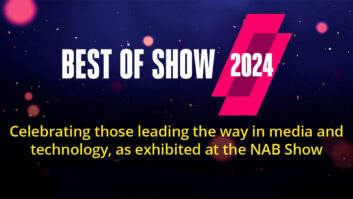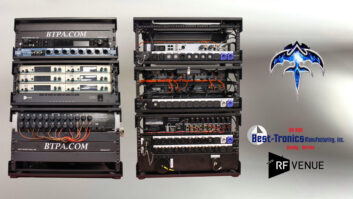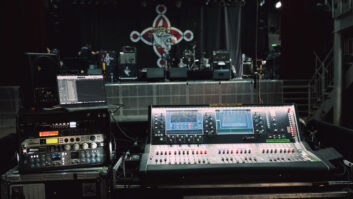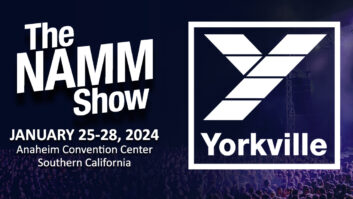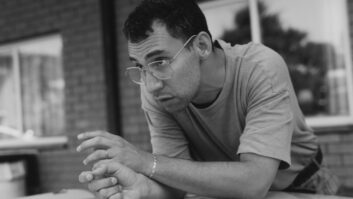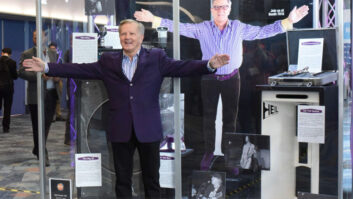Twenty-plus years since they first broke through with hits like “Name,” the Goo Goo Dolls have become a staple of AC radio. If Generation X finds the band’s music to be a comfortable fit, the Dolls themselves are at ease with the songs, too, as evidenced by the fact that the second concert on their recent three-month co-headlining tour with Daughtry was the proverbial “New York show.”
Seen here at the Nikon at Jones Beach Theater in Wantagh, NY, John Rzeznik, lead singer for Goo Goo Dolls, has FOH engineer Michelle Sabolchick use the Waves Maserati Acoustic Guitar plug-in on his acoustic guitars. “It went pretty well,” confirmed Michelle Sabolchick Pettinatu, the band’s FOH engineer. Overseeing an audio system supplied by Clair (Lititz, PA), Sabolchick mixed the Dolls’ nightly 90-minute, 24-song set on a Midas Pro9 console. “Anybody who knows me would be shocked by what I’ve done at FOH,” she reported, “because I’m an old analog girl and I stay away from digital as much as possible, but for this tour, yeah, I’m on the Pro9 and I’ve got a fleet of laptops! One’s running the Waves MultiRack; there’s a Pro Tools laptop for multi-track recording and virtual soundcheck; another one is running Smaart, which I don’t really use but it’s there; and then I’ve got the fourth laptop for the Lake System Controller. So it’s not my typical FOH at all, but it’s a lot of fun.”

Going digital was an opportunity for Sabolchick to explore Waves MultiRack in-depth, it turned out: “Waves came mostly as a request from John Rzeznik, the lead singer. He’s a huge fan—he’s got his own Pro Tools recording rig and loves plug-ins, so we’re using a Kramer Master Tape saturation plug-in and the Maserati Acoustic Guitar plug-in on his acoustic guitars. As the tour goes on, I’m going to dive into it more and see what else I can play with.”
The five multi-instrumentalists on stage created a total of 47 inputs for Sabolchick’s Pro9, all of which were captured by a variety of microphones, most notably the pairing of a Royer R-122 live ribbon mic and a typical Shure 57 on each guitar cabinet. “It’s a great combination for a nice, big fat guitar sound,” she said. “Everything else is pretty much standard—I’m not a big fan of using all the same mic, but I like to use the right one for the right instrument. For instance, my drum kit is a combination of a Beyer M 88 on the kick along with an SM91. I’ve got an AKG 414s for overheads, Opus 88s and then your standard 57 on there.”
Bringing all that to the audience was a typical Clair PA system. “It’s the i-5 with the flown i-5B subs and also the BT-218s for ground subs,” said Sabolchick. The system also included a selection of Clair i-dls and P-2s, and was all powered by Lab. gruppen PLM 20000 amplifiers in Clair’s StakRak format.
Acoustic instruments always have a prominent place in the band’s sound (in fact, the group was on a short acoustic tour earlier this year when Sabolchick first moved to the Pro9 desk), but rock is the main course at their shows. “Goo Goo Dolls is a raw, organic rock sound,” said Sabolchick. “They’re punkish at some points and kind of rock/pop at other points, so it’s a rock-sounding show. They have a few ballads that are a lot of fun to mix. Actually, we did one that was my favorite for the first show and it’s a big, epic ballad about a soldier, but the audience didn’t know how to react because it’s really sad, so they took it out. I was so bummed because it was a blast to mix, but they have a few other ballads that are big hits like ‘Black Balloon’ and ‘Better Days’ where the song builds and you get to get a little creative.”
Chris Daughtry of the band Daughtry sports Sennheiser IEMs while belting into a Shure UR wireless mic. Co-headlining was Daughtry, the perennially touring group led by singer Chris Daughtry, whose fourth-place finish on the fifth season of American Idol became a launch pad for his band, which has since sold more than 23 million albums worldwide. Mixing the act was Reggie Griffith, manning an Avid Venue Profile console to handle 42 inputs coming from the six musicians onstage. The desk housed a number of plug-ins used nightly, including Waves’ SSL G-Master Buss Compressor, MaxxVolume and MaxxBass, as well as TC Electronic’s VSS3 reverb.

Mic-wise, all vocals were captured on Telefunken M80s, although Chris Daughtry used a Shure UR wireless system as well. Palmer DIs captured the guitar amps and drums were grabbed by Sennheiser e604s on toms, and the pairing of a Sennheiser MD421 on the kick with a Shure SM91 to “create a tight, punchy sound with a lot of snap to it—it doesn’t waffle around at all.”
Mixing the band’s pop rock for the first time on the tour provided Griffith with the perfect pallet for his constantly evolving mix style: “About two years ago, I decided to refine my goal in mixing, and that goal became ‘Every mix has to be clear and present.’ A couple of guys I admire—Pete Keppler, who mixes Katy Perry, and Tony Blanc, who was mixing Rihanna—I heard their shows and the clarity was fantastic, but they also had presence: a defined low end that when introduced to the audience wasn’t perceived as bassy, but rather as present. And that’s what I’m doing with this mix; it’s still the music that’s the blueprint— whatever the music is giving me, it’s still full bandwidth with an extreme amount of clarity—but I’m refining it by taking out a lot of low-mid range that muddies up the mix. In both pop and rock, a lot of instruments have that 250 Hz presence that can build up pretty fast, so it becomes an editing thing; I’m taking 250 out in different locations so that the voice winds up right in front but nothing gets lost.”
Applying that depth of analysis is one of Griffith’s strengths; another example was his approach to joining the Daughtry production team. “It’s interesting walking into a job that’s already been established—they’ve been on tour for seven years,” he said. Before talking to the band, he met with monitor engineer Rob Smuder and listened to the singer’s in-ear mix. “Rob was mixing a vocal-heavy, upfront mix that was very clear, and I got a chance to hear Chris’s voice. Then I introduced myself to all the techs and went through their whole show—‘What’s your musician playing on this? Why is he using this one? What’s the gain structure of it?’ It’s not about judgment or how I perceive the person to be; I’m listening, communicating, gaining understanding of how they work and how they relate to the artist long before I get to talk to the artist. I want to know what they’re going after and how I can help them get what they need to get done, and in turn, how they can help me fulfill my goals. So then, I come back into rehearsals and I feel comfortable enough to speak my truth, to say ‘This is what I’m going for, this is my intention—is that something we can do together or should I change it somehow?��”
The approach seems to have worked; months later, the summer tour is only a memory, but Griffith is still mixing the band, having just returned from a USO tour in Japan to run through a string of dates down South this month. December will find Daughtry playing numerous radio station holiday shows, which seems only fitting: “This band, it’s radio-friendly,” said Griffith. “How does that happen today? People know the songs. It’s interesting to see and to be honest, I feel pretty lucky to be mixing a radio-friendly band.”
Clair
Clairglobal.com
Midas
Midasconsoles.com
Avid
Avid.com
Waves
Waves.com
